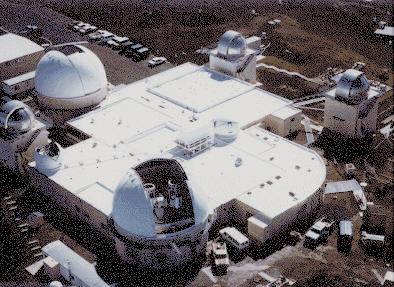



Air Force Maui Optical Station (AMOS)

The Air Force Maui Optical Station (AMOS), an asset of the US Air Force Materiel
Command's Phillips Laboratory, is located at the summit of Haleakala, on the island of Maui, in
the state of Hawaii. It is part of the Maui Space Surveillance Site (MSSS),
The mission of AMOS is to conduct research and development of new and evolving
electro-optical sensors, as well as to provide support for operational missions defined by US and
AF Space Command. In addition, AMOS provides experiment support to a wide variety of
military and civilian organizations in diverse fields. This support has included the Strategic Defense
Initiative Organization (SDIO), the National Aeronautics and Space Administration (NASA), the
Jet Propulsion Laboratory (JPL), and many universities. AMOS has hosted and supported a wide
variety of visiting experiments.
Typical AMOS visiting experiments include:
- support for tactical and strategic missile launches out of both Vandenberg and Kauai
- detection and tracking of orbital debris
- observations of shuttle and satellite special operations
- laser illumination of satellites
- atmospheric physics
- space sciences and astronomy
- the Short Wavelength Adaptive Technology (SWAT), a long term experiment funded by
SDIO and requiring the construction of additional facilities at the observatory
- the Relay Mirror Experiment (RME), funded by SDIO and managed by Phillips
Laboratory, operated in Maui, utilized existing AMOS assets as well as requiring the
construction of additional facilities at the observatory as well as a satellite control and laser
propagation facility at sea level near the town of Kihei. Phillips Laboratory received the
SPIE Technology Achievement Award for 1991 for the dramatic success of RME.
 AMOS telescopes include a 1.6 meter telescope, an 80 centimeter Beam/Director Tracker, and a
60 centimeter Laser Beam Director. MOTIF includes twin 1.2 meter telescopes on a common
mount. GEODSS includes two main 1 meter telescopes and an auxiliary 40 centimeter telescope.
A major upgrade to AMOS will be the Advanced Electro-Optical System (AEOS), a 3.67 meter
telescope scheduled for first light in 1997. AEOS will have seven coude' rooms for various
experiments, as well as conventional Cassegrain positions located on the mount itself.
AMOS telescopes include a 1.6 meter telescope, an 80 centimeter Beam/Director Tracker, and a
60 centimeter Laser Beam Director. MOTIF includes twin 1.2 meter telescopes on a common
mount. GEODSS includes two main 1 meter telescopes and an auxiliary 40 centimeter telescope.
A major upgrade to AMOS will be the Advanced Electro-Optical System (AEOS), a 3.67 meter
telescope scheduled for first light in 1997. AEOS will have seven coude' rooms for various
experiments, as well as conventional Cassegrain positions located on the mount itself.
Sensors associated with these telescopes include a wide range of detectors and imaging arrays
sensitive to the visible and infrared wavelengths. The 1.6 meter telescope has a Compensated
Imaging System which has been operational since 1982. The new AEOS will also incorporate an
adaptive optics system for atmospheric turbulence compensation. Under development is the
AMOS Daytime Optical Near Infrared Imaging System (ADONIS), capable of extending the
AMOS imaging capabilities to 24 hours per day. These adaptive optics systems allow AMOS to
take photographs of orbiting satellites with outstanding clarity, in spite of the severe problems of
dealing with atmospheric turbulence.
Lasers currently available at the site for external propagation include Argon ion lasers, a
Neodymium YAG, and a ruby laser. External laser safety is accommodated with the use of plane
watch personnel in conjunction with guidelines from the local FAA facility. Predictive avoidance is
coordinated with the Laser Clearinghouse to preclude inadvertent illumination of satellites.
In addition to these facilities, the University of New Mexico manages the Phillips Laboratory's
Maui High Performance Computing Center (MHPCC). The MHPCC is a state-of-the-art
computing center using massively parallel processing computers, based on the IBM SPx series.
The MHPCC supports both Department of Defense and civilian users, operating in both classified
and unclassified modes. AMOS utilizes the MHPCC for a significant amount of its image
processing.
RESOURCES
http://www.fas.org/spp/military/program/track/amos.htm
Implemented by Charles P. Vick, Sara D. Berman, and
Christina Lindborg, 1997 Scoville Fellow
Maintained by Steven Aftergood
Updated February 26, 2003